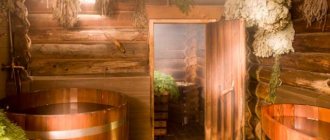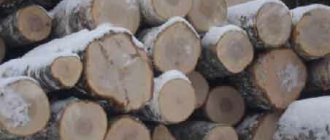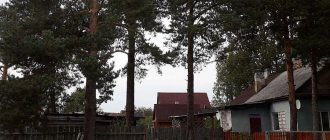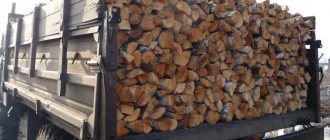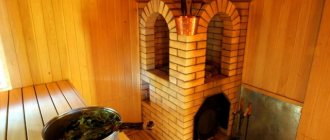Last year I sheathed my two-story bathhouse. There are four rooms on the first and second floors: a living room, a cold sink, a steam room, and a bedroom.
It was necessary to choose lining for 4 different surfaces:
- veranda (outside);
- bedroom, living room (inside), walls and ceiling;
- sink (inside), walls and ceiling;
- steam room, walls, ceiling, shelves.
The most inexpensive lining is pine. This one was used for external walls (veranda, lower roof slopes).
A story from my reader Valentin.
What are the pros and cons of pine, how much will it cost per meter
The main advantage of pine is its price. What other characteristics of the material can be noted?
| pros | Minuses |
| Rot resistance | High resinity |
| Antiseptic properties | It is impossible to wash off the resin, it is easy to get burned from it |
| Ease | Defects in the form of knots falling out over time, resin pockets |
| Smooth texture | Gets darker with time |
| Low heat transfer |
The most common types of lining are:
- A - from 190 rubles per sq. meter;
- B - from 260 rubles per sq. meter;
- C - from 320 rubles per sq. meter.
Bedroom
I used this lining on the veranda, in the living room and bedroom. When I was calculating the cost of the lining, I learned that it should be calculated not like ordinary wooden products in cubic meters, but in square meters of the surface to be covered.
Aspen - building material
Aspen buildings attract buyers due to their relative cheapness. The material is much more accessible than pine, and even more so cedar.
Maybe because hardwoods are valued less than conifers? What’s the matter, what are the pros and cons of an aspen bath and will you later regret this choice?
What disadvantages should you expect?
Aspen was considered a weed tree for a long time. And now some experts don’t like her.
Cause:
- probability of defects;
- a very soft core, which if it begins to rot, will infect the entire log.
The fresh surface of the wood may leave scratches and dents. But later it becomes almost “stone”, so it is almost impossible to process such aspen. Dark spots are another effect that can be considered a disadvantage, as they visually age even a new building.
What are the advantages?
Some disadvantages can be avoided if you take the selection process seriously. For example, trunks with a damaged core will only be received by those who are too lazy to check them for defects.
Tip: treat the wood with an antiseptic in advance to avoid stains.
Finishing the sauna with aspen
Aspen has low thermal conductivity and low water absorption; in addition, it has long been noted that the material has bactericidal properties. For example, in such wells the water does not bloom even in extreme heat. For lovers of everything unusual, we can say that there is a belief that aspen can absorb negative energy.
Let's start building
Below are general instructions that will help you understand the main stages of construction.
Columnar foundation
There are several types of foundations for a wooden bath, but the most promising is considered to be a pillar foundation. The price of such a foundation is significantly lower than other options.
The main element is a pile (pillar), made of:
- wood;
- bricks;
- concrete;
- reinforced concrete;
- asbestos pipes filled with concrete.
You can install the poles with your own hands in the corners of the building, under the joints of walls and other places with heavy loads. The usual step between piles is 2 m; if it is larger, intermediate supports should be installed.
Most often, concrete blocks are used, under which a sand cushion is made. They must be covered on top with a waterproofing material, for example, two layers of roofing felt.
Construction of a log house from aspen
Walls
Now it’s time to build walls, and you can save on construction by purchasing rounded logs.
The initial costs will be offset by the lack of additional interior finishing.
- Connection into a “bowl”. The logs produced on special machines have a perfectly smooth surface, and the sawn bowls exactly match the radius of the logs. This guarantees that the log house will be practically airtight, and an ideal microclimate will be created in the room.
If you want to carve the bowls yourself, consider whether it's worth it. The price of the material will increase by only 20%, and you will have to spend more than one day and it is not a fact that you will be able to outperform a woodworking machine.
- Insulation. Each crown must be lined with a special jute fabric based on flax, which is not afraid of moisture and is not eaten by rodents and insects.
- Fastening logs. Secure the crowns together with wooden dowels. Before this wood drill, holes are drilled in adjacent logs.
Windows and doors
You can start sawing them in the log house after laying half of the logs. However, there is no need to rush, as some will have to be left as binders for now. They will allow the walls not to lose verticality during shrinkage.
Roof construction
The final stage is installing the roof in the bathhouse and insulating it. Its design depends on the size of the room, the type of foundation and the terrain; its shape can be varied.
Its role cannot be overestimated; it protects the bathhouse from:
- wind;
- snow;
- rain,
and also allows you to effectively save heat in the room.
Gable roof for bathhouses made of logs
Characteristics of linden logs
Before answering the question of which is better linden or aspen for a bathhouse, you need to know the features of both materials. We talked about the latter above, now it’s the linden’s turn.
What can you say about her:
- it has low density;
- dry material is light in weight;
- has low resin content;
- has low thermal conductivity;
- soft in structure;
- dries quickly;
- has a light tone.
- rarely cracks;
- does not settle;
- has a pleasant aroma, which is believed in folk medicine to relieve tension and calm the nerves;
- affordable price due to easy processing of the material.
Advantages of linden
In addition, the smell irritates rodents, which is why in Rus' linden barns were considered the best; mice entered there very rarely and the grain in them did not spoil.
Finishing the bath with linden boards
Flaws
One thing worth highlighting is the fragility of operation due to the soft structure. Because of this, the surface of the log becomes vulnerable to moisture, which inevitably leads to the formation of fungus. To increase the service life of the log house, you will have to carefully care for it.
Advice: use linden for buildings that are needed for a short time or are located close to your place of residence so that it is not expensive to monitor them.
From the above, we can say the following, although linden baths have been built in Rus' since time immemorial, today there are better materials for such buildings.
And if you take a pine tree
A pine log house is noticeably superior in quality to an aspen one, but in some characteristics it is inferior to its analogues made of elite cedar or larch (see also the article “Larch bathhouse - exquisite savings”). The material is optimally suited for people with average incomes. Before you understand which bathhouse is better from aspen or pine, you need to know the characteristics of the latter.
Sauna made of pine logs
What's good about pine wood?
- The pine trunk is naturally straight and has relatively few small knots. This indicator is considered the most important advantage of the material.
- The second advantage is environmental friendliness. The healing properties of resinous pine scent have been known for a long time. It helps fight cardiovascular diseases and makes life easier for people who regularly endure stress.
- Other natural characteristics:
- broad-coniferous has the best thermal insulation;
- red – the most durable;
- yellow – the densest;
- white is universal, its price is cheaper than others.
Growing conditions also play a big role for pine wood. Northern breeds are valued higher, but only if they did not grow on marshy soils.
What causes complaints
- During humid and hot seasons, pine logs may develop a slightly reddish or bluish tint, which somewhat reduces their aesthetic appeal. This is not rot and this fact does not affect the reliability of the bathhouse design.
- You can get rid of this effect with the help of protective compounds, which should be applied to the surface of the logs in a timely manner.
- Pine is a resinous material, so it should be used carefully in “hot” areas of the bathhouse, where the temperature of the resin can cause skin burns. It can be pre-heated, but the cost of such material will be significantly higher.
Pine clapboard trim
What are the pros and cons of linden, how much will it cost per meter
I had to cover the steam room with linden, even though it is expensive. I always didn't like small steam rooms, so I made myself a big one.
There I placed shelves of such length that you could stretch out to your full height on them. This led to the need to buy an expensive stove and expensive lining.
The size of the steam room is 4*2.5 meters, the ceiling height is 2 meters. Accordingly, I had to buy 2*(4+4+2.5+2.5)=26 sq. meters.
The main advantage of linden lining is its low thermal conductivity. You won’t get burned on such a surface in a steam room, where the temperature can rise to 100 °C. But the main disadvantage is its softness, you can scratch it just by running your fingernail.
The cost of a square meter of linden lining is now 1,900 rubles per square meter. Compare with the cost of pine paneling: this one costs almost 10 times more! But comfort is worth any money.
At first I thought about covering the entire steam room with linden, but then I decided that I could save a little and cover only the walls with linden clapboard - they are touched while steaming. He put pine on the ceiling.
Steam room.
By the way, the shelves themselves also had to be made from linden.
Comparison of two tree species
Pine and aspen are used more often than other wood to create log bathhouses. This is due to their prevalence and relatively low price. Although it is impossible to call the construction of log houses cheap.
As building materials, pine and aspen have a number of differences:
- Pine is a coniferous tree , and aspen is a deciduous tree . Therefore, pine logs at high temperatures begin to release pine essential oils, which in large doses cause headaches and even suffocation. In addition, during the first five years the pine will actively resin, so visitors to the steam room can easily get burned by hot resin drops. As for aspen, there are no such problems with it.
- The building material of these rocks varies greatly in price . Aspen has a soft center that is often susceptible to disease and rot. A seemingly healthy tree can be destroyed from the inside. Most often, this phenomenon occurs in Russia, so most often aspen is ordered from abroad. But even so, defective aspen beams are more common than pine beams. Because of all this, aspen is much more expensive than pine.
- As a building material, pine is easier to process than aspen. In addition, the longer a tree lies, the harder it is to cut it down.
- Aspen is more durable than pine. Pine is more susceptible to the development of fungus and mold and is less moisture resistant. An aspen bathhouse will serve its owners for decades.
What are the pros and cons of aspen, how much will it cost per meter
The main advantages of aspen lining:
- dense wood structure, unlike linden;
- strength;
- moisture resistance;
- durability;
- color retention over time;
- pleasant aroma.
There were some downsides:
- gets very hot;
- minor defects, knots that fall out over time due to changes in temperature and humidity;
- burns from knots.
Source: ecowood27.ru
The cost of aspen lining is much lower than linden lining. Now it is sold in stores from 550 rubles for grade A and from 800 rubles for extra grade. The price would be nice, but it can’t be used in a steam room, so I didn’t use this lining at all when building a bathhouse.
Pine for log bathhouses
Coniferous trees are quite easy to process due to the softness of the wood. It is not difficult to make an ideal rounded beam from pine. However, it is worth remembering that existing knots, when exposed to high temperatures, release resin, which can cause burns. The resin seeps out up to five years of operation of the log house. After which the tarting practically disappears. Therefore, coniferous wood is usually not used for interior work. If the steam room is decorated with pine boards, the smell of pine needles will last for a long time.
An essential characteristic of pine logs is a low degree of deformation and minimal cracking during drying. A significant disadvantage of wood is its high susceptibility to putrefactive processes and infection not only by fungi, but also by wood parasites. A characteristic feature is also the change in color of the tree cut: the initially yellow-pink tint becomes brown.
Pine is popular as a building material for baths due to its availability in almost every region and its relatively low cost.
Comparative characteristics of aspen and pine
When choosing a material for constructing a wooden bath, the following points should be taken into account:
- softness of wood: pine is easier to process;
- cracking: aspen splits violently when dried out;
- deformation: practically does not support coniferous trees;
- susceptibility to parasites: pine is often inhabited by insects and mold;
- durability: aspen will last for several decades;
- price: aspen is more expensive than pine.
What to choose for building a log house? Each person has their own preferences, plans and financial capabilities. To achieve what you want and create inner harmony, you should focus on personal feelings. One person likes the fresh coniferous aroma of pine, while another likes the sound of dry aspen. Experienced experts recommend using different types of wood in the construction of log houses for interior and exterior work.
Options for lining for a steam room
Cladding with clapboard is a popular way of cladding walls in a bathhouse. The type of material used, class and processing method determines the main criterion for choosing lining for a bathhouse. You should also choose the appropriate material for seats, shelves and additional decorative elements.
For installation work in the steam room, panels made of deciduous trees (alder, aspen, beech, ash, etc.) are used. This material has a flat and smooth surface without any kind of damage. And beneficial substances released under the influence of high temperatures have a beneficial effect on human health.
Depending on the density of the structure and the outer surface, the lining is divided into classes. Classes “Extra” and “A” are of the highest quality (smooth surface without damage or deformation). Classes “B” and “C” are slightly lower in quality due to the presence of visible surface imperfections (knots, cracks). Eurolining is classified as a separate subspecies. Due to a different method of processing wood, it is distinguished by a large size of the tongue-and-groove joint and the ability to remove excess moisture through special grooves.
Which lining profile is better
The “soft-line” profile has a narrower ridge and a wider board. The wall in the bathhouse with such lining looks less pockmarked and looks stylish.
Eurolining is not just a beautiful name or brand. This is truly European quality production, or at least a bold claim to it. Basically, eurolining is famous for the fact that it does not change its width when it dries - it is manufactured according to the international standard DIN 68126, where the standards are much more stringent than those of the Russian GOST 8242-88. Because of this, eurolining has a different profile, grade, size, quality of surface treatment and humidity indicators. For example, the mentioned international standard requires that slats have longitudinal ventilation grooves on the back of the boards, which would remove condensation and relieve internal stress in the wood. And it is inevitable in the steam room due to serious changes in humidity and temperature. Also, the eurolining has a deeper tongue-and-groove lock than its Russian counterparts. And, naturally, eurolining is the most expensive on the market.
So which lining for a bathhouse is both better and more profitable? The answer is simple: the one that is of better quality. Now we’ll tell you how to recognize quality.
Oak
Oak is a sound wood species. The heartwood of the tree is dark red, tan or light yellow. In addition, oak wood is very hard, strong, it is resistant to rotting, increased strength and beautiful texture.
Oak wood is commonly used in the manufacture of furniture and in cooperage. The resistance of oak to moisture allows the use of oak products in conditions of high humidity. This material is used to produce edged and unedged boards, furniture blanks, parquet, veneer, and doors.
Aspen in landscape design
It is important to understand where the aspen tree grows in order to use it in landscape design. It prefers well-lit areas and crowds out other plant varieties.
Representatives of this species grow quickly, forming up to 3 meters of young growth in the first years. They are not afraid of heat and frost, and quickly recover after winter. However, they have one problem - the center of the trunk often rots.
With age, trees become loose and fragile, so when growing them under cultural conditions, it is important to check their condition annually.
Aspen is popular in landscape design not only for decorative purposes, but also due to its beneficial properties:
- aspen plantings provide good protection from the wind;
- on the banks of reservoirs, wood prevents soil from sliding;
- in large populated areas it is used for landscaping and air purification;
- rarely catches fire.
Aspen is widespread everywhere. In most cases, it forms separate plantings, displacing less strong trees. In nature, it reproduces by seeds, but it is more convenient to purchase and plant seedlings. These are strong trees with a wide root system, unpretentious to growing conditions. They are popular in construction and landscaping, and continue to be used in the preparation of folk medicines.
Wooden lining: price and cost determining factors
Knowing the cost factors helps you make the right choice when purchasing finishing materials for a bath. The modern market offers many options for rocks from which lining can be made. The price depends on the production methods and raw materials used to create the finishing material. And the type of wood is a decisive factor. In general, all wood is naturally susceptible to environmental conditions, but some species are more resilient than others. Therefore, the most difficult trees to process are expensive, which means the cost of lining increases. Pine and spruce are considered the most budget-friendly, yet high-quality options. By nature, this material is resistant to warping and rotting, and visually such products beautifully highlight the interior. Larch and alder belong to the middle price segment. These rocks are not picky about the external environment and do not require serious production costs, which determines how much the lining will cost as a result. Linden also belongs to the middle price segment, but products from this species are more popular due to the availability, durability and health-promoting qualities of the natural material.
In addition to the species, the cost of the finishing material is also affected by the quality of the wood itself. The region and growing conditions of a tree determine its future characteristics. In the north, pine grows more slowly, and the distance between annual rings is small. It is important to take into account that in production, denser wood is valued than loose wood, so often “northern” species will belong to the elite class. The higher the quality of the rock, the more valuable and the longer the lining will last. The price per m2 is higher for those products that grow in hard-to-reach regions. Different breeds may have different prices due to growing conditions.
Advantages of linden lining:
- Wide range of applications
- Lack of resins and harmful substances in wood
- Useful phytoncides and essential oils released by wood
- Softness, lightness and ease of handling
- Unique honey aroma
- Natural decorative effect: wood appearance, unique pattern
- Heat and sound insulation properties
- Low thermal conductivity
- Strength and elasticity
- High performance
- Excellent mechanical and technical properties
Let us note that when choosing materials for finishing, customers most often give preference to lining made of linden wood. This choice can be explained by the significant advantages of linden wood.
Ash
Ash is a soundwood species. The wood has a light brown core with a brownish tint. This is a durable and strong material with high mechanical and physical properties, which is also easy to process and finish. Products made from ash are also distinguished by high impact strength and flexibility.
Ash is valued in carpentry; it is used for the production of veneer in the furniture industry, for finishing walls and laying floors. Eurolining, formwork, beams, unedged and edged boards, solid parquet boards, and railings are made from ash.
Advantages
Aspen wood has low thermal conductivity and almost does not crack; it lends itself well to various processing techniques, even bending. It can be easily polished and painted. The material is relatively light, attractive white, with fine fibers. Ease of processing is also associated with a minimal number of knots. If processed correctly, objects become strong and resist rotting very well.
The condition of patients with rheumatism, bronchial and pulmonary inflammation, even dysentery improves
It is important to remember that this cannot in any case replace full-fledged treatment, and any measures of this kind must be agreed with doctors

